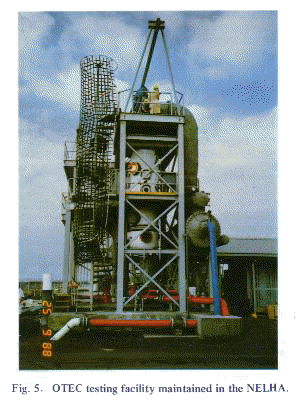The Natural Energy Laboratory of Hawaii Authority (NELHA) was established in July 1990 through the merger of the Natural Energy Laboratory of Hawaii (NELHA) and the Hawaii Ocean Science and Technology (HOST)Park. NELH was established for the research, development, and demonstration of OTEC and OTEC-related technologies; while HOST Park was established to support the large scale commercialization of those technologies. Together, the facilities provide 869 acres dedicated to economic development of the state through the use of the unique resources at Keahole point: cold deep seawater, warm surface seawater, and an abundance of sunshine.
In 1982 a single 12" pipeline system began operating to provide up to 1100 gallons per minute (gpm) of cold seawater from a depth of 2000'. The temperature of the water at this depth is approximately 43¢K. There are currently 11 deep seawater pip1ines in service supplying warm and cold seawater. The diameters of the pipe1ines range from 12" to 40". Designing and deploying these pipe1ines have made them to become one of the most experienced OTEC term in the world.
In addition, both closed-cycle and open-cycle OTEC research projects have also been successfully carried out at the lab. A recent project studied the heat and mass transfer characteristics of the being used to design a net power producing open-cycle OTEC plant, Research on heat exchangers has led to a major breakthrough which promises significant cost reductions for closed-cycle OTEC.
Besides the engineering oriented developments, the water that is pipe ashore is avai1iable for use in other applications including aquacu1ture studies. The ability to supply large amounts of water at temperatures varying from about 45¢Kto 85¢K permits many different species of marine life to be grown. The pathogen-free, nutrient-rich cold deep seawater has produced some amazing results.

Kelp, a macroa1gae which is grown in the cold seawater to feed abalone and sea urchin, has a significantly increased growth rate and protein content compared to kelp growing naturally in the ocean. Results such as these have contributed greatly to the success of aquac1ture business. At this time there are six businesses at NELHA which are actually producing marketable aquacu1ture products Cyanotech Corporation produces two varieties of microa1gae: Spiru1ina, a complete food and the highest source of vegetable protein, essential amino acids and B vitamins and Duna1iella, valued for its high levels of beta-carotene which appear to be a preventive of certain types of cancer. Ocean Farms of Hawaii is growing abalone, sea urchin, salmon, oysters and kelp. The kelp and salmon grow together symbiotically in four, 4 acre ponds. Like Cyano-tech, OFH depends on the many sunny days to maintain the high growth rates of algae. Edible sea-weeds are grown at Raya1 Hawaiian Sea Farms: Ogo which is the branched, crispy seaweed used in poke; and nori which is most often seen as a processed sheet wrapped around sushi. They also grow eleebe, a long green, hair-like seaweed indigenous to Hawaiian waters and prized in local cuisine. These seaweeds are marketed fresh and RHSF has several delicious recipes available. Aquaculture Enterprises is growing coldwater lobster. By controlling the temperature of the water and providing a daily diet of local seafood, the lobsters reach a marketable size in less than half the time required in their natural environment. Taste tests have shown these domestic lobsters to be comparable in flavor and texture to their relatives caught in the wild off the northeast coast of the United States. A company from Japan, Uwajima Fisheries, is culturing hirame, a Japanese flounder, which will be sold to sushi bars and specialty markets in Hawaii.
Air-conditioning, a practical use of the coldness of the deep seawater is demonstrated in the research lab. This 4000 square foot building is cooled by an air-conditioner which uses the cold seawater to cool the air-conditioning system's fresh water. The result is a savings of about $400 each month on the electrical bill.The agric1tural projects use only the coldness of the deep seawater as it flows through pipes which lie on the surface of the soil or are buried in the soil. Moisture in the atmosphere is condensed on the outside of the cold pipes providing continual drip irrigation to the plants. The chilling of the soil tricks the plants into thinking that they are grown in Oregon or in the mountains of Chile rather than the sunny shores of Hawaii. Soil refrigeration produces strawberries with a higher sugar content and a more bountiful yield than those grown in non-chilled soil. A1stoemera, a flower which is highly prized by florists, is native to the mountains of Chile where there is abundant sunshine and cool soil. This rare flower is made to bloom in the hot volcanic soil found at NELHA by using the same method of soil refrigeration. Chilled pipes running through the soil cause the plants to produce a year-round abundance of pink blossoms.
All of these exciting projects in energy, aquaculture and agricu1ture are presented in the informative 1ectures each Thursday hosted by the NELHA.
